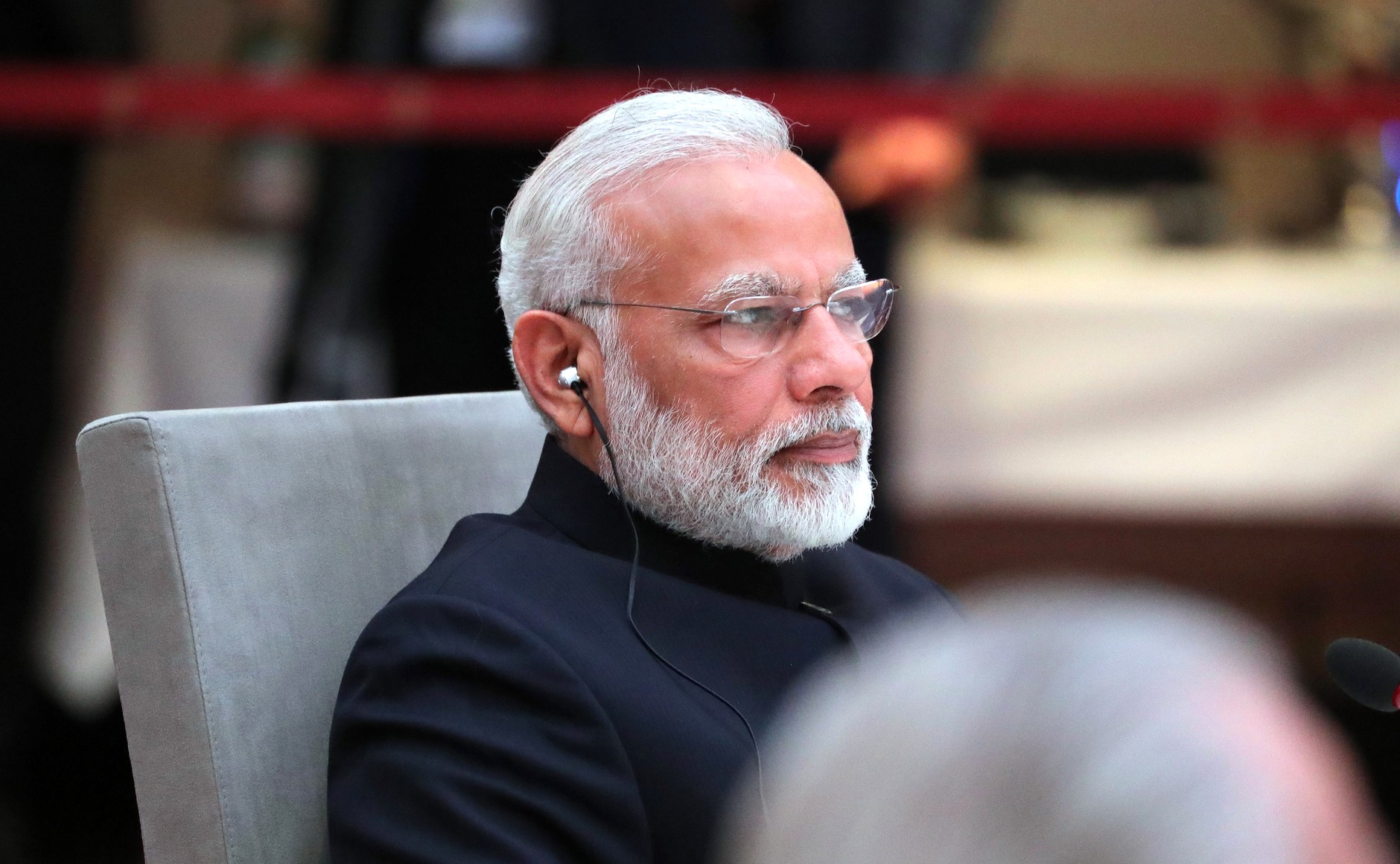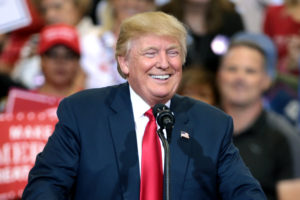Indian Democracy Is Being Dismantled Piece by Piece
Prime Minister Narendra Modi has made a mockery of parliamentary debate and party dialogue, embracing a fascist rhetoric of "us vs. them." Indian Prime Minister Narendra Modi. (Wikimedia Commons)
Indian Prime Minister Narendra Modi. (Wikimedia Commons)
There were some notable differences between the swearing-in ceremonies of the Hindu-supremacist government of Narendra Modi in its first victory on May 26, 2014, and its re-election on May 30, 2019.
The 2014 victory was tentative yet triumphant. There were attempts to paint a narrative of the South Asian leaders who were invited, including Pakistani Prime Minister Nawaz Sharif and others. While Indian elite and stars from Bollywood dotted the forecourt of the president’s residence (Rashtrapati Bhawan, in New Delhi), the message to neighbors was that India is the Big Brother offering a hand to other nations. Modi, who touts the humble beginnings he overcame, has repeatedly shown a penchant for trying to make history and create a grand narrative. By the 2019 swearing-in ceremony, it seemed that Modi’s government had abandoned the pretense that India needed the approval of the outside world.
India’s first prime minister, Jawaharlal Nehru, was a celebrated internationalist. His firm belief in collaborations among the developing nations, fed on his socialist roots, led him, along with other legendary leaders, to the emergence of the Non-Aligned Movement (NAM). There was a major shift for India in the 1990s when the Indian National Congress, under a leadership committed to freeing India from a controlled economy, chose the path of neoliberal economics, drawing closer to the United States and Israel.
Then came the vitriol of the campaign that led to Modi’s first victory, his almost no-holds-barred unleashing of hatred, and his rhetoric of “us versus them” (where “us” can only mean “Hindu India”—never mind the segregations of caste complications that come with the term). His master stroke of inviting “enemy nation” Pakistan to share the glory of his electoral win was hailed by many as a strategic shift—one that never materialized.
Appealing to a vast section of India as the “tea seller” from a humble background, there was no shame for his followers that the man aspired to riches, wearing an outrageously expensive coat (when he met President Obama in Delhi months later) or using a luxe Mont Blanc pen as he signed documents to take his oath—crass expressions of personal wealth.
The first five years of the regime were signs of the time to come. An immediate centralization of power, an assault on university campuses (especially on student leaders who questioned this hegemonic and proto-fascist ideology that has groomed Modi since teenage years), cutbacks on workers’ and farmers’ rights, arrests on activists and lawyers and worst of all, lynchings of Indians who did not fit the definition of the ‘ideal’ Indian—that is, Muslims, Dalits, Christians and communists (read: dissenters) were brutally killed. The slaying of rationalists Narendra Dabholkar, Govind Pansare, M.M. Kalburgi and Gauri Lankesh (only the first happened before 2014) by an extreme right-wing group was also something India has not seen. The ideology of this Bharatiya Janata Party (BJP) regime is the Rashtriya Swayamsevak Sangh (RSS). Founded in 1925, its core belief is that India should not be a democratic republic but a Hindu theocracy; it subscribes to unequal and discriminatory levels of citizenship (following both Mussolini and Hitler) and is wedded (in its own writings) to overthrow the Constitution. Propaganda around the glory of the nation and “development” subsumed the gory 2014-2019 reality of violence, fear and lynchings. The unilateral move to “liberalize” India’s legal currency crippled India’s flagging economy and virtually killed the informal sector. Reports of the aggrandizement of the ruling party’s coffers came in only to be snuffed out by men who led the party and were intolerant of media reporting reality. Those men are now in positions of unbridled power today.
I wrote some months ago that this government has all but declared a war against its own people. That was before the 2019 results that took the supremacist victory to even higher levels, making a mockery of parliamentary debate and all-party dialogue. The second Modi regime sworn in this year has demonstrated in just three months what we can expect.
Parliament, which met to pass the budget in July, has been used thereafter to push through legislation without even the show of referring them to parliamentary committees for consultation or feedback. Not only does this second regime seem in a particular hurry, but, as Modi’s swearing-in ceremony on May 30 showed—the number of guests at the same venue had doubled to 8,000—there was no need (nor inclination) this time for India to send any messages internationally. One-sixth of the world lives in India, and as sole spokespersons for those over whom they now rule, the Modi 2.0 regime felt no real need to assuage any foreign concerns.
The first session of Parliament in 2008 made rushed amendments to the Unlawful Activities Prevention Act (UAPA) that perverted its meaning in a way that sanctioned the curbing of civil liberties of minorities, as well as nationalist violence against them under the guise of fighting vaguely defined terrorism. (Before that, the UAPA had last been amended by the 2004 Indian National Congress party-led regime with the intention of preventing terrorism—and, ironically, at the time, those amendments were supported by the supremacist BJP, with only the parliamentary left vociferously opposing validating laws that had serious questions for personal liberties.) Even during the previous 10 years of Congress rule—which had an otherwise decent record—of legislating on rights (be it the right to information, right to rural work, right to food, or rights of forest workers/Adivasis), these draconian provisions of the then-amended UAPA were used selectively in targeting youth from the minority on charges—often judged by courts to be fabricated—of “terrorism.” Now these aberrations have been taken a step further. And the Modi 2.0 regime has now passed an amendment that allows even an individual to be unilaterally declared a terrorist—without judicial scrutiny and only by the government’s executive decision—and his/her properties to be attached and seized. As if these amendments were not bad enough, the completely unilateral and unconstitutional abrogation of Article 370 of the Indian Constitution and stripping the state of Jammu and Kashmir of its special status (a legal requirement under the state’s Instrument of Accession to the Indian Union) on August 5 are the worst examples of Modi 2.0 regime’s running roughshod over law, decency, morality and the Constitution.
The Kashmir Valley has been blocked in or blotted out, internet and communications shut down, even landline phone connections shut down. A fundamental decision that affects the very existential reality of the Kashmiri people has been taken without hearing their voice or representation. The state has been under the president’s rule for months. If the Modi 1.0 government will be recognized for subverting and perverting India’s institutions by appointing to crucial posts men and women who have no regard for notions of equality and non-discrimination, then the second time around, the regime will be known for targeting any opposition to Indian federalism. No Indian state is now safe from these rapacious hands.
How did the Modi 2.0 regime notch up its spectacular victory?
A realistic assessment before the results were out was that the BJP itself would get about 180-200 and the National Democratic Alliance party would notch up about 220 or 240 seats out of the total 542 seats that make up the Indian Parliament. It’s the 80-100 seats extra and the massive margins in some that appeared programmed (and even manipulated for some) to send out a message.
The manner in which the Election Commission of India (ECI) functioned through the entire seven-stage polling phase has raised eyebrows. There was clear effort neither to question the huge display of funds (beyond legal limits) used by the ruling party nor to check violation of election law, through misuse of official position or speech that violated constitutional norms (read: hate speech). More money was spent on the Indian 2019 election than on the American elections ($6 billion!), of which 80 percent was spent by the ruling BJP. They have, through their enactment of a non-transparent and opaque law (electoral bonds)—during the last term—ensured that they both have the money and do not need to disclose the source. Neither the ECI nor India’s Supreme Court has in any real sense questioned this abuse. This reflects on the erosion (if not complete takeover) of India’s institutions whom we expect to uphold foundational constitutional principles.
The RSS, the ideological backbone of the BJP election machine, has always had a formidable cultural and social presence, again made easy with the free flow of funds from abroad to its various outfits. Whether the RSS works on charity or education, a core component is its ideological slant, bending or perverting Indian minds toward an unquestioning authoritarianism where a supremacist male Hindu hierarchy is both valorized and validated.
Through demonetization and election bonds, that access to funds has grown even further, and the BJP now has an election machine that can compete with the RSS’s octopus-like organization.
Propaganda, the key tool of any authoritarian protofascist regime, is run or fueled through the BJP’s paid saffron shirts. The party has put in place a formidable 24–hour–connected network that disseminates their message (read: propaganda), which is not one message but rather several layered messages: these praise the one strong leader willing to strike out for drastic change, vilify the opposition (the BJP since its last term has spoken of a “Congress-mukt [free] Bharat [India]”), “promote” every government scheme that they have introduced—its efficacy multiplied and glorified a thousand times over through this well-oiled propaganda—and all the while, layer this with a subconscious message of othering and “hatred.”
Months before the May 2019 elections, the poor economic conditions, farmers’ protests, a revived and belligerent opposition, and charges of corruption over the Rafale deal had started to bother the BJP’s dispensation of propaganda. Come February 2019 and the Pulwama terror attack on Central Reserve Police Force (CRPF) personnel in the Kashmir Valley was quickly diverted away from the abysmal intelligence and governance failure that it was, and instead spun into a high-voltage, chest-thumping show of nationalistic machismo. Within a week, a staged “attack” on Pakistan at Balakot—even the efficacy, efficiency and truth behind this raises serious questions—provided the requisite miniscule and banal fodder to refurbish Modi as the man India needed, the man against evil.
Finally, serious questions of electronic voting machine (EVM) tampering have also been raised that cannot be wished away. The battle to be fought needs to factor in and deal with all of these things. The scarcely veiled and calibrated messages of Muslim-bashing/othering, aggressive pseudo-nationalism, and the “selling” of the government schemes need to be dealt with. As does the shameful belittling of the opposition that is also happening at alarming speed with little regard for facts or the truth. It is this formidable body of misinformation and meticulously well-organized and well-oiled/heeled organization that we collectively need to counter.
How, is the question? Who can do this? Political parties in the Opposition that look moribund need to be moved, shoved, and pushed by Indian citizens. Remember also that (unlike in 2014 when even if the results were more startling, they at least appeared believable) this time, state power has also been (illegally) used to garner data from Facebook and other platforms to the service of one party, to help further disseminate the propagandist message, through WhatsApp groups and Facebook messaging. There is also the structural issue of sections of voters who have been deliberately or otherwise disenfranchised (missing voters). The questions to address remain: How will we rectify those missing voters? And how will we bring voters out to the polls?
A hard and meticulous strategy for political education and cultural messaging that includes the history and relevance of principles of constitutionalism is as relevant today as ever before and needs to be not just created and disseminated but organized. Every space, school, college, office, and gram panchayat needs to be involved. The campaign needs to be sustained, layered, fun, historic, relevant, and aimed at building real perceptions away from heaps of propaganda-filled hate.
Two little instances give me hope. One is from last month, when left parties organized a protest at Azad Maidan in Mumbai against the dismantling of Article 370 of the Constitution. Many present felt that engaging with the Mumbai commuter was useful. There was curiosity in the midst of misinformation, that then can be our first lesson: how do we refurbish energies toward rebuilding a sense of resistance after first establishing our new sense of communities?
Second, our Opposition may be weak in Parliament. However, can Indians creatively work to show a strong united opposition on India’s streets?
This article was produced by Globetrotter, a project of the Independent Media Institute.
Teesta Setalvad is a writer, activist, and journalist living in India. She is a writing fellow for Globetrotter, a project of the Independent Media Institute, and the secretary of Citizens for Justice & Peace. She has been a longtime advocate for civil rights for all Indian citizens, especially minorities and women.
Your support matters…Independent journalism is under threat and overshadowed by heavily funded mainstream media.
You can help level the playing field. Become a member.
Your tax-deductible contribution keeps us digging beneath the headlines to give you thought-provoking, investigative reporting and analysis that unearths what's really happening- without compromise.
Give today to support our courageous, independent journalists.






You need to be a supporter to comment.
There are currently no responses to this article.
Be the first to respond.